The community of Dharavi is considered by some to be the largest slum in the world. It occupies the most contested land in Mumbai, India. Originally located on the outskirts of the city, the settlement is now in the center of the expanding city and the land it is built on has risen in value exponentially. Proposals to redevelop Dhariavi (primarily the Mukesh Mehta designed Dharavi Redevelopment Plan, or DRP) have not included the residents of the settlement, nor taken into consideration their lifestyles and livelihoods.
The design intervention seeks to remedy this lack of information and interaction by literally making visible the proposed re-blocking and housing schemes of the development plan. This occurs via three interlinked but distinct interventions; the painting of the DRP re-blocking line on the ground and buildings of Dharavi, highlighting the incongruities, 'awareness centers' built off the most contested areas of the slum, where residents con go to learn what can be done to contest the plan and how it affects them, and the construction of housing type facades along the busiest streets in the community, bringing into stark relief the differences between housing types that support the lifestyles and livelihoods of the residents of Dharavi, and the homogenized and unresponsive high-rise typologies being pushed by the DRP.
All these interventions allow the residents of Dharavi to become aware of how the DRP affects them individually and collectively, giving them the ability to appropriate undesired aspects of the plan and alter them to become more acceptable to the community and as minimally disruptive as possible.
The design intervention seeks to remedy this lack of information and interaction by literally making visible the proposed re-blocking and housing schemes of the development plan. This occurs via three interlinked but distinct interventions; the painting of the DRP re-blocking line on the ground and buildings of Dharavi, highlighting the incongruities, 'awareness centers' built off the most contested areas of the slum, where residents con go to learn what can be done to contest the plan and how it affects them, and the construction of housing type facades along the busiest streets in the community, bringing into stark relief the differences between housing types that support the lifestyles and livelihoods of the residents of Dharavi, and the homogenized and unresponsive high-rise typologies being pushed by the DRP.
All these interventions allow the residents of Dharavi to become aware of how the DRP affects them individually and collectively, giving them the ability to appropriate undesired aspects of the plan and alter them to become more acceptable to the community and as minimally disruptive as possible.
Completed at University College London.

The Dharavi Redevelopment Plan (DRP) hinged on the division of Dharavi into 5 sectors, to be redeveloped by the 5 individuals or organizations that bid the highest. The new 5-Sector plan, with its seemingly arbitrary division lines, did not reflect the realities of the community at all. Additionally, the majority of the residents of Dharavi either did not know that a redevelopment scheme for their home was proposed, or did not know the details of how it was to be done. In order to bring awareness of the DRP to the community, as well as explicitly show how the plan affected them, the lines of the proposed 5-Sector plan are drawn on the ground and buildings of the slum



A critical aspect of the design intervention proposal is enacting a shift in the power relations playing out between the residents of Dharavi and the proponents of the DRP. Currently, the residents have little to know power in this relationship, the DRP is very much being imposed upon them. A key reason for this is the lack of knowledge, interaction, and collaboration being given to the community. Via these interventions, this starts to shift. The residents become informed not only of what the DRP is and how it affects them, but how they can empower themselves to enact a change in it. One step in this process is the physical act of re-drawing the DRP sector plan to more accurately reflect the realities of how (and where) Dharavi operates

Located off the red DRP line in areas of the most contestation are 'Awareness Centers'. These are places in which community members can gather to learn more about the DRP, how it affects them, and what options are available to them to influence and alter the plan. These centers will have maps, drawings, and other resources not normally available to the residents. Members of local NGOs and community groups will be available for consultation and discussion. The centers can also double as offices for local savings groups, supplying a safe in which to keep collected funds

The DRP's default housing (provided to the current residents of Dharavi providing they meet a stringent checklist of pre-requisites) is high-rise, uniform, and disconnected from how most of the members of the community need to live in order to continue with their livelihoods and lifestyles. The illuminate this conundrum outlines of housing type facades are constructed on opposite sides of busy thoroughfares within the Dharavi community, one side the homogenized DRP typologies, and the other the diverse and lower-level typologies reflecting the needs of the community.

The resident-supported housing, appropriated and constructed by the residents themselves, has images of community members portrayed on the facades of the various unit types, to personalize the housing that the DRP seeks to homogenize.

[board one of my presentation]

[board two of my presentation]







